J'Accuse! Janna Kalman's 122-year longevity record - fake?
For many gerontologists, Jeanne Kalman is almost like Jeanne d'Arc for the French. Symbol, legend, shrine. Jeanne d'Arlle 's record for life expectancy at 122 years and 164 days is known by every true wrestler with aging. It was installed in 1997 and since then nobody even managed to get close to it - the second place barely exceeds 119 years, and the third place is 117. Of the now-living survivors, the oldest are only 115 years old. Given that after 100 years of age, the annual probability of dying fluctuates around the 1/2 mark, the chances of sentiaries live to be 122 years old are incredibly small.
But in gerontological circles, the achievement of Joan is in no doubt questioned. On the contrary, it is referred to as the “most validated long-liver”. And indeed, she has everything in order with the documents - she was born and lived all her life in one place, in the city of Arles in the south of France, and, being from a fairly wealthy bourgeois family, appears in many official sources. However, the correct documents are not a guarantee of the absence of fraud, because according to your documents someone younger can live. For example, your daughter.

And Jeanne had a daughter. Yvonne Marie Nicole Kalman was born in 1898, when her mother was almost 23, and died, according to the documents, on her 36th birthday, exactly in 1934. Moreover, the act of her death was issued on the basis of the testimony of not a doctor, but only some unemployed 71-year-old woman who “saw her dead”:

And that's the thing, on those rare photos of Yvonne that survived - and in old age Jeanne ordered to burn all the family photos - it was she who most of all resembled the woman who lived until 1997. Moreover, the photo of Yvonne in his youth for some reason became the “calling card” of the youngest Jeanne, and is given out for her even on such respected sources as Wikipedia:
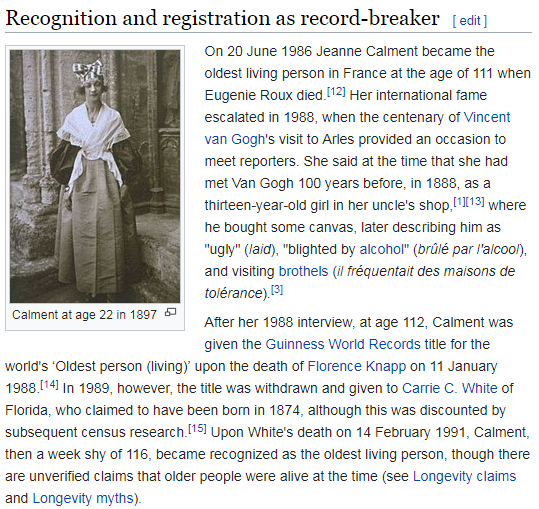
Let's analyze this photo in detail. Here it is in good resolution, and a little colored by the algorithm :

Peer into these bold eyes opposite:

Now think: is this similar to the photo taken in 1897, when Joan was 22? Or is it more like a much more progressive, if not dissolute, 1920s? Facial expression and hairstyle add credibility to the second option, but here I am not an expert. Therefore, I called for the help of those who understand this, and the “fashionable sentence” coincided with my assumption:

Indeed, the haircut is much more similar to the style of the 1920s . For example, the Queen Mother in 1927:

Finally, what is most interesting, in one of Jeanne's biographies , a photo with a bow was signed exactly as “Yvonne, daughter of Jeanne”, and above him is a photo of young Jeanne, much more in line with the Victorian spirit of the end of the XIX century:

Preserved a few more photos of young Jeanne:
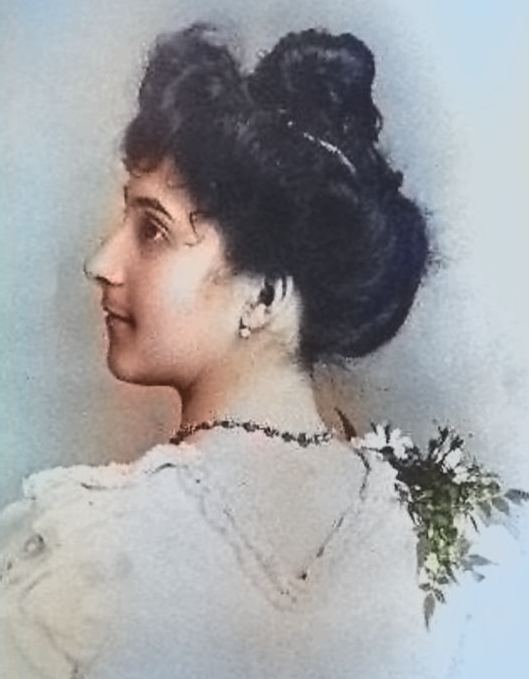
As well as photos of Jeanne and her husband (Father Yvonne):
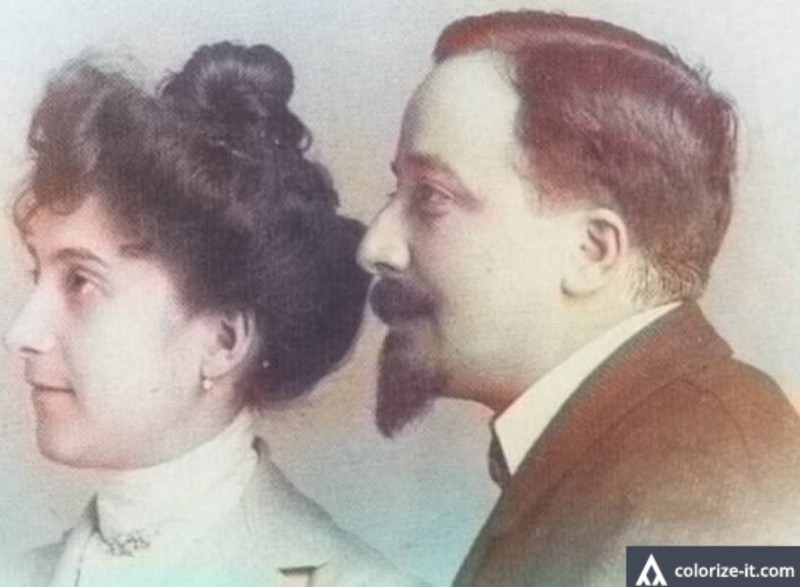
Let's now look at mom and daughter in a more mature age, the blessing we were lucky that one such photo still survived. Here it is:
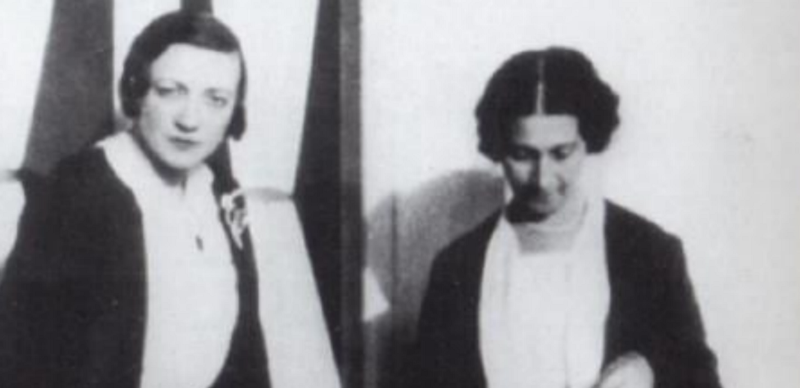
In my opinion, there can be no doubt that Yvonne is on the left and Jeanne is on the right. Here is a photo of the real Jeanne in chronological order:

It seems to me that even the dress is the same (on the left - the photo from Zhanna's ID):

But the “girl with the bow” is, of course, Yvonne:
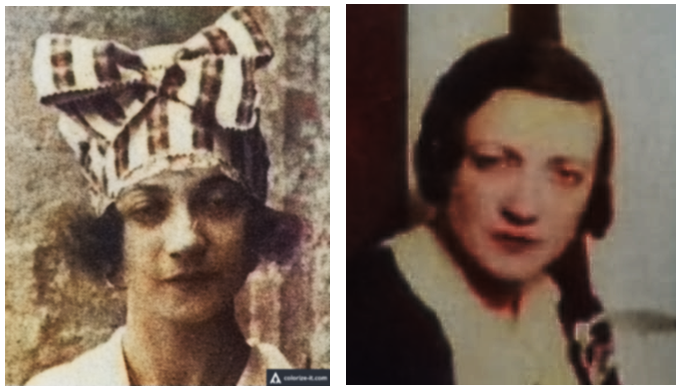
And if you compare a photo of a young and an adult Yvonne with photos of an old and old Joan, then the similarity can also be seen with the naked eye:

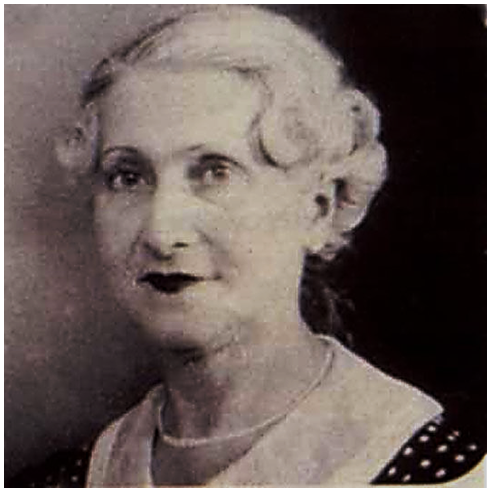
In my opinion, the photo above is a clue. Who is this, Jeanne or Yvonne? Because, just like in “Highlander”, by that moment there was only one left. If Yvonne really died in 1934, at the age of 36, she could never look so old.
For a full analysis we will take a step back. Here are two interesting photos. The first one is young Jeanne, and the second one is young Yvonne trying to recreate the first one. Looks like Yvonne loved copying mom from a pretty early age:
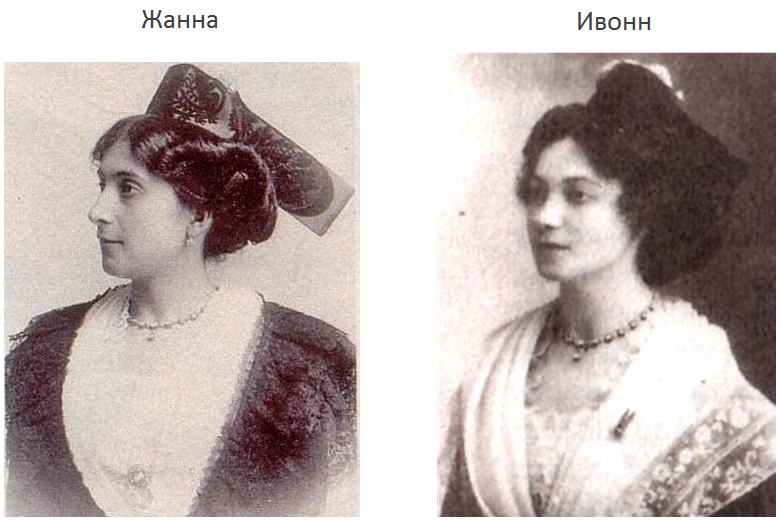
We see a clear difference in the chin and lower jaw. Yvonne also has a longer and wider neck with a more pronounced jugular fossa. Here is a close-up:

Let's compare now photos of young Yvonne with our mysterious photo. Chin, lower jaw, neck, jugular fossa - everything is very similar:

Circled in red and green parts are generally identical:
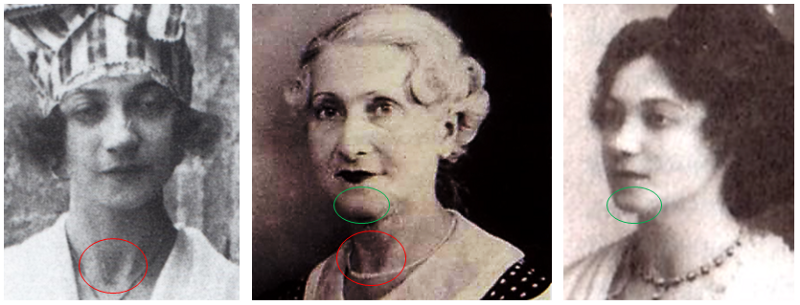
And if you compare with Jeanne?
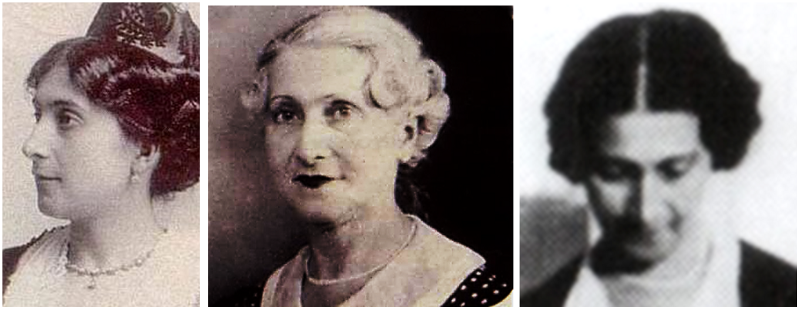
The woman in the photo in the middle has a much wider, more rounded face than Joan in the extreme right photo. Her neck is longer and wider, and the jugular notch is more pronounced.
Below I have added a photo of the old "Jeanne" along with two confirmed photos of young Yvonne on the left:

When you look at these four photos together, there is almost no doubt that all this is one person, and that the mysterious photo belongs to him - Yvonne. In my opinion, everything is clear:

By the way, the shape of the nose of the old woman is more like the shape of the nose of Yvonne’s father, rather than the shape of the nose of the young Jeanne:

Well, old Jeanne doesn’t look like herself in her youth - neither with her nose, nor with her jaw, nor with her chin:

In this case, we must pay tribute, - parents Yvonne were similar to each other, which is not surprising, since they were second cousins brother and sister.
Okay, enough to guess the photo, let's move on to other interesting questions. First, why would Yvonne need to impersonate his mom? The answer is prosaic - so that the family can get away from the inheritance tax, which in 1934, at the time of the death of the real Jeanne, could reach as much as 38% . All the charms of this tax, their family could feel for themselves only a few years before, when Jeanne's father died in 1931 (Jeanne's mother died earlier in 1924).
In France, and now very severe inheritance taxes, and in the 1930s, they were still more severe. For example, even inheritance between spouses was taxed , and this rule was abolished only in 2007. Moreover, the surviving spouse had the same rights to the property of his deceased spouse (or even to her half of their joint property), like her children and even cousins or sisters ! Therefore, if Jeanne herself died in 1934, her family could suffer financially very much from this - her husband would have to pay a considerable tax on his large store, and also potentially share it with his deceased deceased wife.
The scale of the family shop Kalman couple can be estimated from the photo below. It was not just a shop, it was a large multi-storey building, which her husband, Fernan Kalman, inherited from his parents, and which he headed from an early age — his father died in 1886, when he was only 18 years old. Fernand not only worked in this house, but also lived there with his mother. Joan also moved there after marriage.

In the photo below, Jeanne's husband himself in front of his shop window in 1907 (in the depth, in a light jacket, marked by the right arrow):

Here’s what Kalman’s son, the longest-serving employee there, with the second arrow in the photo above, tells about the store and the family:
My eye caught the bold line. Could an eight-year-old boy remember how well Yvonne Kalman “knew how to live” if she officially died in 1934, when he was only 8 years old, like her son Fredy? Perhaps a bold line is a kind of Easter eggs for its own kind of wink? Because this letter was written for the local “Arleans Bulletin” and was hardly intended for a wide audience.
By the way, it is interesting that Yvonne is no longer in the 1931 census . Her parents are there, like her husband and her son, everyone lives together, even the servants are counted, and Yvonne is not:

“Copy error”, say the validators of the authenticity of the record Madame Kalman. Well, maybe. Or maybe the real Jeanne was already dead? And Yvonne disguised herself as the wife of her father, entangling the scribes of the population so much that they first wrote her down under the name of their grandmother, Mary (see above). And 3 years later, Yvonne decided to formally legitimize his “death,” with her birthday chosen on January 19, the date of this death. It is in the spirit of the naughty and daring lover of hunting and fencing. Okay, let's not guess, let's consider other inconsistencies.
One of the inconsistencies is connected with Van Gogh, about whom old Kalman very unflatteringly responded , calling him “an ugly, rude, smelling smell of a brothel.” Ostensibly, Jeanne intersected with him in their family store in 1888 and even sold him either a canvas , or paints , or pencils . And in some sources, the store owner for some reason is called the father of Jeanne, and in others - the uncle. But Jeanne's parents had no store, her father was a hereditary shipbuilder, and very successful and well-off. The store was at the second cousin of uncle Jeanne (father of the future husband), and he was in 1888 - the year when Van Gogh came to Arles for 15 months - was already 2 years old as dead.
In any case, it’s somehow difficult for me to imagine a 13-year-old girl from a rich bourgeois family working in 1888 behind a shop counter. At least, in adulthood, neither Jeanne nor Yvonne did not work a single day. By the way, according to the validators, at this time Zhanna was supposed to study at the Catholic boarding school (Benet private boarding school) - it would be interesting to confirm this data in the school's archival documents, and at the same time look at the students' daily routine.
In another interviewin 1989, Jeanne claimed that her husband had introduced her to her store in Van Gogh when he went to buy canvases there. He said: “Look, this is my wife!” Considering that in 1888 Joan was only 13 years old, this sounds strange. But her future husband (and Yvonne's father) at that time, most likely, worked in the store - he was 20 years old, and after his father’s death it is quite logical that he took over the management of the family business. Perhaps he once told his wife and daughter about meeting with Van Gogh, and then Jeanne began to attribute this meeting to herself.
It was in the house where the Kalman family store was located until 1937 that “Zhanna” used her apartment for “the worst insurance deal of the century” in 1965 - having pledged to transfer it to a certain Andre-Francois Raffray after her death in exchange for the obligation to pay her a lifetime monthly pension. in 2500 francs. For the next 30 years, Raffre paid Jeanne an amount far in excess of the cost of the apartment, and did not wait for the cherished living space, dying of cancer. And payments to Joan after his death did not stop.

By the way, it is curious that this case is described in Jean-Pierre Daniel’s book “Insurance and its secrets” as a scam known in narrow circles of insurers. Here is what he writes:
About “she took the identity of her mother in order to continue receiving rent ”, the author clearly messed up, as Jeanne began to receive rent only in 1965, 31 years after the death of her daughter-mother. It is also not entirely clear how exactly the obligation to pay the rent, which Raffra assumed, was provided by the insurance company, although it is quite possible that he decided to hedge his risk and pre-insured Jeanne’s life in a special way , which provided not a lump sum payment after her death, but monthly payments up to - starting, say, from 100 years.
But back to the very Joan. Another interesting circumstance is that after Yvonne's death in 1934, her husband, who was 43 years old at that time, never married again, and continued to live with his “mother-in-law” and his son in the same house until the end of his days. This, of course, does not prove anything, but, at a minimum, does not contradict the hypothesis that Yvonne did not die, but simply began to impersonate herself as a mother.
In 1942, Yvonne’s father and Jeanne’s husband died of cherry poisoning, and in 1963, Jeanne’s grandson and son-in-law died (or Yvonne’s son and husband). After that, Zhanna led a rather quiet, if not to say secretive life. Even on her 100th birthday, she refused the offer of the mayor of Arles to arrange a public celebration of this very rare achievement. The mayor himself recalled very curious details:
The paradoxical preservation of Joan was also amazed by professional gerontologists who investigated her phenomenon. I was surprised by her ability to stand and move without assistance in 113 years:
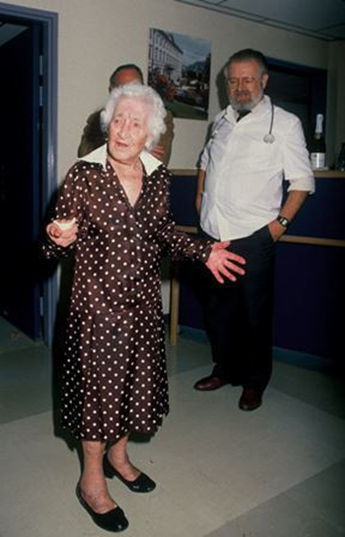
Moreover, at 114, her height was 150 cm, which was only 2 cm less than her stated height in adulthood:
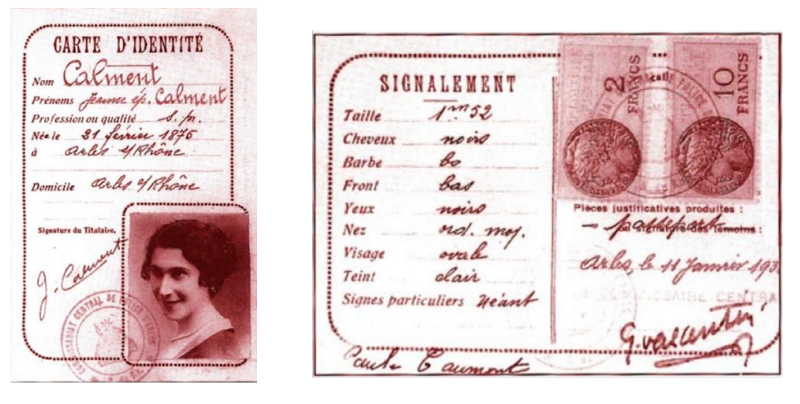
Considering that usually after 40 years of age, growth begins to fall, and, on average, by the age of 80 women decrease by 6 cm, such preservation of Jeanne is almost unique:

But Yvonne, it seems, was both bigger and taller than Joan:
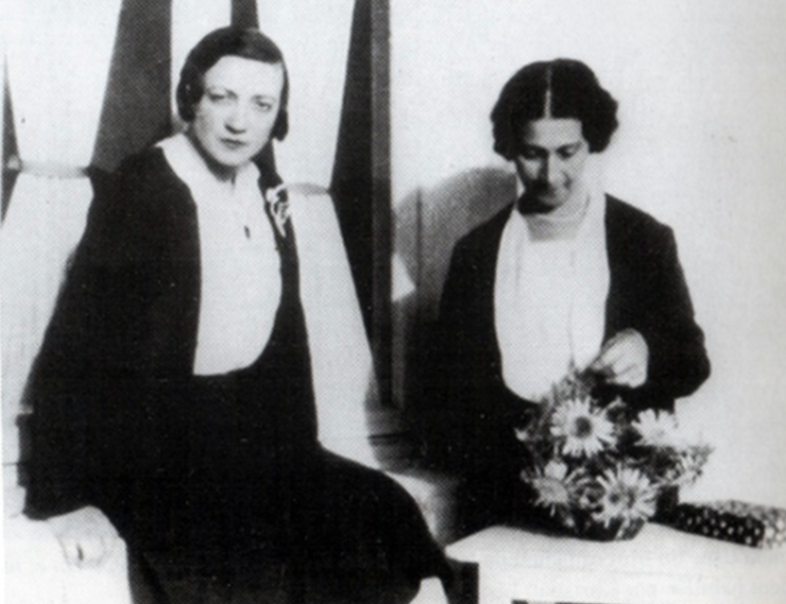
By the way, in Jeanne’s ID card above, the color of her eyes is indicated as “black,” although old Jeanne’s color is clearly different:
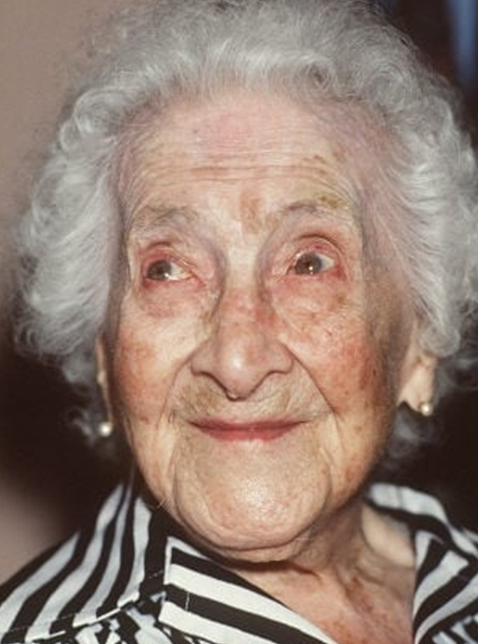
Finally, at 118 years old, Zhanna underwent various cognitive tests for 6 months , in which she showed results at the level of 80–90-year-olds.
Sometimes Jeanne, it seems, uttered in her memoirs, then calling her husband father, saying that her mother’s name Gilles is her grandmother’s name, although Jeanne didn’t have a grandmother with that name (in those days her wife’s name did not ). One of these punctures was when Zhanna told that when she was a child, maid Marta Fusson drove her to school, although according to the 1911 census , Marta Fusson was born 10 years later than Zhanna and only Yvonne could drive to school, with whom she lived same census.
Of course, every single mistake in the memories or discrepancy in the biography of Jeanne could be attributed to an accident. But in aggregate, all of them make, at a minimum, want to understand much deeper into the biography of this extraordinary woman. Hopefully, the gerontological community will support this idea, and not accept it as a sacrilege.
In conclusion, I want to say that practically all the evidence base on which this material is based is the merit of Nikolai Zak , and the idea of a more detailed study of Jeanne’s biography belongs to the well-known Russian gerontologist Valery Novoselov . For those who are interested in delving into this topic, I can offer to get acquainted with the primary sources from Nicholas ( article , slides ), as well as readInterview on this topic with V.M. Novoselov.
Yes, and a big request: if you find out something new to confirm or refute the theses expressed here, please share it. You can here in the comments, you can in PM.
UPD: From the moment of this publication new interesting facts surfaced. For example, the old and the young Joan have different ears. Details can be read here .
But in gerontological circles, the achievement of Joan is in no doubt questioned. On the contrary, it is referred to as the “most validated long-liver”. And indeed, she has everything in order with the documents - she was born and lived all her life in one place, in the city of Arles in the south of France, and, being from a fairly wealthy bourgeois family, appears in many official sources. However, the correct documents are not a guarantee of the absence of fraud, because according to your documents someone younger can live. For example, your daughter.

Was there a girl?
And Jeanne had a daughter. Yvonne Marie Nicole Kalman was born in 1898, when her mother was almost 23, and died, according to the documents, on her 36th birthday, exactly in 1934. Moreover, the act of her death was issued on the basis of the testimony of not a doctor, but only some unemployed 71-year-old woman who “saw her dead”:

And that's the thing, on those rare photos of Yvonne that survived - and in old age Jeanne ordered to burn all the family photos - it was she who most of all resembled the woman who lived until 1997. Moreover, the photo of Yvonne in his youth for some reason became the “calling card” of the youngest Jeanne, and is given out for her even on such respected sources as Wikipedia:

Let's analyze this photo in detail. Here it is in good resolution, and a little colored by the algorithm :

Peer into these bold eyes opposite:

Now think: is this similar to the photo taken in 1897, when Joan was 22? Or is it more like a much more progressive, if not dissolute, 1920s? Facial expression and hairstyle add credibility to the second option, but here I am not an expert. Therefore, I called for the help of those who understand this, and the “fashionable sentence” coincided with my assumption:

Indeed, the haircut is much more similar to the style of the 1920s . For example, the Queen Mother in 1927:

Finally, what is most interesting, in one of Jeanne's biographies , a photo with a bow was signed exactly as “Yvonne, daughter of Jeanne”, and above him is a photo of young Jeanne, much more in line with the Victorian spirit of the end of the XIX century:

Preserved a few more photos of young Jeanne:

As well as photos of Jeanne and her husband (Father Yvonne):

Main evidence
Let's now look at mom and daughter in a more mature age, the blessing we were lucky that one such photo still survived. Here it is:

In my opinion, there can be no doubt that Yvonne is on the left and Jeanne is on the right. Here is a photo of the real Jeanne in chronological order:

It seems to me that even the dress is the same (on the left - the photo from Zhanna's ID):

But the “girl with the bow” is, of course, Yvonne:

And if you compare a photo of a young and an adult Yvonne with photos of an old and old Joan, then the similarity can also be seen with the naked eye:

Key photo

In my opinion, the photo above is a clue. Who is this, Jeanne or Yvonne? Because, just like in “Highlander”, by that moment there was only one left. If Yvonne really died in 1934, at the age of 36, she could never look so old.
For a full analysis we will take a step back. Here are two interesting photos. The first one is young Jeanne, and the second one is young Yvonne trying to recreate the first one. Looks like Yvonne loved copying mom from a pretty early age:

We see a clear difference in the chin and lower jaw. Yvonne also has a longer and wider neck with a more pronounced jugular fossa. Here is a close-up:

Let's compare now photos of young Yvonne with our mysterious photo. Chin, lower jaw, neck, jugular fossa - everything is very similar:

Circled in red and green parts are generally identical:

And if you compare with Jeanne?

The woman in the photo in the middle has a much wider, more rounded face than Joan in the extreme right photo. Her neck is longer and wider, and the jugular notch is more pronounced.
Below I have added a photo of the old "Jeanne" along with two confirmed photos of young Yvonne on the left:

When you look at these four photos together, there is almost no doubt that all this is one person, and that the mysterious photo belongs to him - Yvonne. In my opinion, everything is clear:

By the way, the shape of the nose of the old woman is more like the shape of the nose of Yvonne’s father, rather than the shape of the nose of the young Jeanne:

Well, old Jeanne doesn’t look like herself in her youth - neither with her nose, nor with her jaw, nor with her chin:

In this case, we must pay tribute, - parents Yvonne were similar to each other, which is not surprising, since they were second cousins brother and sister.
The motive of transformation
Okay, enough to guess the photo, let's move on to other interesting questions. First, why would Yvonne need to impersonate his mom? The answer is prosaic - so that the family can get away from the inheritance tax, which in 1934, at the time of the death of the real Jeanne, could reach as much as 38% . All the charms of this tax, their family could feel for themselves only a few years before, when Jeanne's father died in 1931 (Jeanne's mother died earlier in 1924).
In France, and now very severe inheritance taxes, and in the 1930s, they were still more severe. For example, even inheritance between spouses was taxed , and this rule was abolished only in 2007. Moreover, the surviving spouse had the same rights to the property of his deceased spouse (or even to her half of their joint property), like her children and even cousins or sisters ! Therefore, if Jeanne herself died in 1934, her family could suffer financially very much from this - her husband would have to pay a considerable tax on his large store, and also potentially share it with his deceased deceased wife.
The scale of the family shop Kalman couple can be estimated from the photo below. It was not just a shop, it was a large multi-storey building, which her husband, Fernan Kalman, inherited from his parents, and which he headed from an early age — his father died in 1886, when he was only 18 years old. Fernand not only worked in this house, but also lived there with his mother. Joan also moved there after marriage.

In the photo below, Jeanne's husband himself in front of his shop window in 1907 (in the depth, in a light jacket, marked by the right arrow):

Here’s what Kalman’s son, the longest-serving employee there, with the second arrow in the photo above, tells about the store and the family:
My poor father, Marius Maxence, who worked in this store for 7 years before World War I and 20 years after, was the oldest employee at the time of closing the store. After 27 years of faithful service (and the medal of labor), he was forced to change profession.
...
The Kalman store had a very large area between Antonefle Place, rue Gambetta, rue St Esteve and rue Jean Granaud. The side of Rue Gambetta was reserved for the sale of fabrics of all kinds. With large shelves up to the ceiling and stairs to access the various shelves.
...
I remember in the 1930s I came to my father's shop (I lived only a hundred meters from the bridge). I played with Fredy Bilot, a grandson born of Yvonne Kalman and Colonel Bilot. We had a difference of several months, and we hid behind banks or behind furniture.
...
The Kalman family was well known in Arles. You could even say that it was the bourgeois family who knew how to live, including Colonel Bilotte and his wife Yvonne Kalman.
My eye caught the bold line. Could an eight-year-old boy remember how well Yvonne Kalman “knew how to live” if she officially died in 1934, when he was only 8 years old, like her son Fredy? Perhaps a bold line is a kind of Easter eggs for its own kind of wink? Because this letter was written for the local “Arleans Bulletin” and was hardly intended for a wide audience.
By the way, it is interesting that Yvonne is no longer in the 1931 census . Her parents are there, like her husband and her son, everyone lives together, even the servants are counted, and Yvonne is not:

“Copy error”, say the validators of the authenticity of the record Madame Kalman. Well, maybe. Or maybe the real Jeanne was already dead? And Yvonne disguised herself as the wife of her father, entangling the scribes of the population so much that they first wrote her down under the name of their grandmother, Mary (see above). And 3 years later, Yvonne decided to formally legitimize his “death,” with her birthday chosen on January 19, the date of this death. It is in the spirit of the naughty and daring lover of hunting and fencing. Okay, let's not guess, let's consider other inconsistencies.
van Gogh
One of the inconsistencies is connected with Van Gogh, about whom old Kalman very unflatteringly responded , calling him “an ugly, rude, smelling smell of a brothel.” Ostensibly, Jeanne intersected with him in their family store in 1888 and even sold him either a canvas , or paints , or pencils . And in some sources, the store owner for some reason is called the father of Jeanne, and in others - the uncle. But Jeanne's parents had no store, her father was a hereditary shipbuilder, and very successful and well-off. The store was at the second cousin of uncle Jeanne (father of the future husband), and he was in 1888 - the year when Van Gogh came to Arles for 15 months - was already 2 years old as dead.
In any case, it’s somehow difficult for me to imagine a 13-year-old girl from a rich bourgeois family working in 1888 behind a shop counter. At least, in adulthood, neither Jeanne nor Yvonne did not work a single day. By the way, according to the validators, at this time Zhanna was supposed to study at the Catholic boarding school (Benet private boarding school) - it would be interesting to confirm this data in the school's archival documents, and at the same time look at the students' daily routine.
In another interviewin 1989, Jeanne claimed that her husband had introduced her to her store in Van Gogh when he went to buy canvases there. He said: “Look, this is my wife!” Considering that in 1888 Joan was only 13 years old, this sounds strange. But her future husband (and Yvonne's father) at that time, most likely, worked in the store - he was 20 years old, and after his father’s death it is quite logical that he took over the management of the family business. Perhaps he once told his wife and daughter about meeting with Van Gogh, and then Jeanne began to attribute this meeting to herself.
The worst insurance deal of the century
It was in the house where the Kalman family store was located until 1937 that “Zhanna” used her apartment for “the worst insurance deal of the century” in 1965 - having pledged to transfer it to a certain Andre-Francois Raffray after her death in exchange for the obligation to pay her a lifetime monthly pension. in 2500 francs. For the next 30 years, Raffre paid Jeanne an amount far in excess of the cost of the apartment, and did not wait for the cherished living space, dying of cancer. And payments to Joan after his death did not stop.

By the way, it is curious that this case is described in Jean-Pierre Daniel’s book “Insurance and its secrets” as a scam known in narrow circles of insurers. Here is what he writes:
Everyone remembers that Jeanne Kalman officially died at the age of 122, August 4, 1997. At that time, it was said that this lady had a life annuity, and this is true. This rent was provided by a large French company, which such exceptional longevity did not please. Moreover, the company was well aware that it does not pay for Jeanne Kalman, but for her daughter. In fact, after the death of the true Zhanna Kalman, her daughter, who at that time was no longer herself a child, took the identity of her mother in order to continue receiving rent. The insurance company discovered identity theft, but with the consent - or on request? - The authorities did not betray it to publicity, since the "elder of the French" was a legend.
About “she took the identity of her mother in order to continue receiving rent ”, the author clearly messed up, as Jeanne began to receive rent only in 1965, 31 years after the death of her daughter-mother. It is also not entirely clear how exactly the obligation to pay the rent, which Raffra assumed, was provided by the insurance company, although it is quite possible that he decided to hedge his risk and pre-insured Jeanne’s life in a special way , which provided not a lump sum payment after her death, but monthly payments up to - starting, say, from 100 years.
Everything is wonderful and wonderful
But back to the very Joan. Another interesting circumstance is that after Yvonne's death in 1934, her husband, who was 43 years old at that time, never married again, and continued to live with his “mother-in-law” and his son in the same house until the end of his days. This, of course, does not prove anything, but, at a minimum, does not contradict the hypothesis that Yvonne did not die, but simply began to impersonate herself as a mother.
In 1942, Yvonne’s father and Jeanne’s husband died of cherry poisoning, and in 1963, Jeanne’s grandson and son-in-law died (or Yvonne’s son and husband). After that, Zhanna led a rather quiet, if not to say secretive life. Even on her 100th birthday, she refused the offer of the mayor of Arles to arrange a public celebration of this very rare achievement. The mayor himself recalled very curious details:
“When I learned that a man from Arles turns 100 years old,” Jacques said, “I had to go to her house, by tradition, inviting her family and bring a gift. It was a failure, polite, but firm. Madame Kalman did not want the ceremony: no drums, no trumpets, no presents, no pie. She was assured that no one would know about her century. Then Zhanna agreed to come to the city hall herself. I waited for Joan for a long time at the reception until it became clear that one of the sitting women, who was hard to give more than eighty by appearance , was a hero of the day. ”
The paradoxical preservation of Joan was also amazed by professional gerontologists who investigated her phenomenon. I was surprised by her ability to stand and move without assistance in 113 years:

Moreover, at 114, her height was 150 cm, which was only 2 cm less than her stated height in adulthood:

Considering that usually after 40 years of age, growth begins to fall, and, on average, by the age of 80 women decrease by 6 cm, such preservation of Jeanne is almost unique:

But Yvonne, it seems, was both bigger and taller than Joan:

By the way, in Jeanne’s ID card above, the color of her eyes is indicated as “black,” although old Jeanne’s color is clearly different:

Finally, at 118 years old, Zhanna underwent various cognitive tests for 6 months , in which she showed results at the level of 80–90-year-olds.
Sometimes Jeanne, it seems, uttered in her memoirs, then calling her husband father, saying that her mother’s name Gilles is her grandmother’s name, although Jeanne didn’t have a grandmother with that name (in those days her wife’s name did not ). One of these punctures was when Zhanna told that when she was a child, maid Marta Fusson drove her to school, although according to the 1911 census , Marta Fusson was born 10 years later than Zhanna and only Yvonne could drive to school, with whom she lived same census.
Of course, every single mistake in the memories or discrepancy in the biography of Jeanne could be attributed to an accident. But in aggregate, all of them make, at a minimum, want to understand much deeper into the biography of this extraordinary woman. Hopefully, the gerontological community will support this idea, and not accept it as a sacrilege.
In conclusion, I want to say that practically all the evidence base on which this material is based is the merit of Nikolai Zak , and the idea of a more detailed study of Jeanne’s biography belongs to the well-known Russian gerontologist Valery Novoselov . For those who are interested in delving into this topic, I can offer to get acquainted with the primary sources from Nicholas ( article , slides ), as well as readInterview on this topic with V.M. Novoselov.
Yes, and a big request: if you find out something new to confirm or refute the theses expressed here, please share it. You can here in the comments, you can in PM.
UPD: From the moment of this publication new interesting facts surfaced. For example, the old and the young Joan have different ears. Details can be read here .
